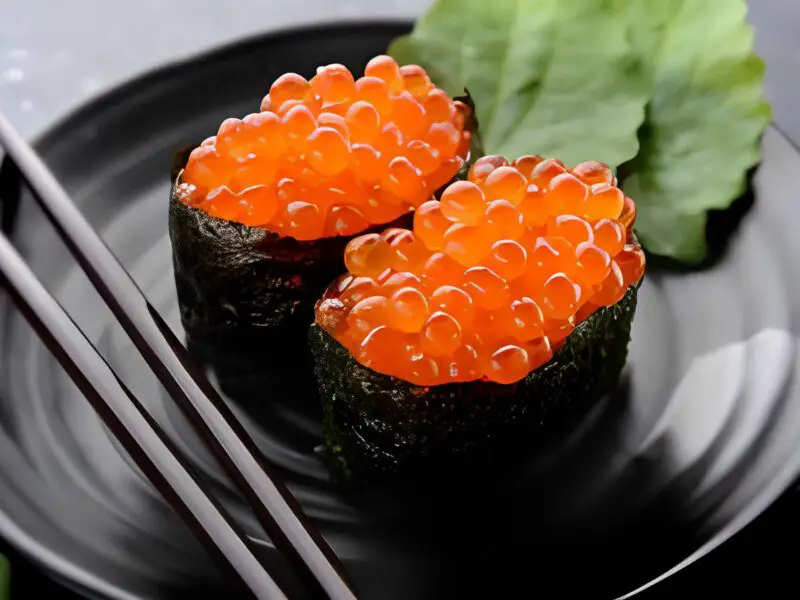If you’ve ever savored the exquisite delights of Japanese cuisine, you might have encountered the enchanting world of fish roe. Nestled atop your sushi or adding a burst of flavor to your sashimi, these tiny, glistening orbs, known as ikura and tobiko, can leave your taste buds dancing.
But what sets ikura and tobiko apart? In this mouthwatering journey, we’ll dive deep into the sea of knowledge, exploring the subtle and not-so-subtle differences between these delectable fish eggs. So, grab your chopsticks, and let’s embark on a culinary adventure!
Ikura: The Jewel of the Ocean
The Salty Symphony
Ikura, my friends, is the caviar of the salmon world. These glorious spheres, approximately 3.5mm in diameter, flaunt a beguiling reddish-orange hue, reminiscent of a setting sun over the Pacific.
They owe their captivating color to some secretive pigment compounds that play a crucial role in their allure. But it’s not just about looks. The curing process infuses these roe with a salty punch, ensuring that each bite transports you to the briny depths of the ocean.
Soy sauce and sake also make cameo appearances in the curing process, adding layers of flavor to the mix.
Versatile, Yet Distinct
In Japanese cuisine, ikura is the chameleon of fish roe. You can find it on its own, or as a dashing garnish on various sushi creations. It pairs beautifully with noodles, creating an irresistible pop sensation with every chew.
But it’s not just about taste; ikura is a nutritional powerhouse. It’s rich in healthy fats, vitamins, and protein. So, while you’re indulging your palate, you’re also giving your body a little boost.
Tobiko: The Playful Popping Pearls
A Colorful Affair
Tobiko, on the other hand, hails from the flying fish species and is a different ballgame altogether. Sporting a vibrant orange, it’s like the neon lights of the ocean. But there’s a twist in this tale – it’s not just about orange.
Tobiko loves to play dress-up. It can be black, thanks to squid ink, red with a hint of chili pepper, or don a light green jacket flavored with the fiery Wasabi. So, with tobiko, you can taste the rainbow!
Crunch, Pop, and a Dash of Sweetness
Tobiko has an identity that’s truly its own. These little orbs are petite, clocking in at under 1 millimeter in diameter or even less. Salt-cured just like its counterpart, tobiko possesses a unique, slightly sweeter taste that sets it apart from the crowd.
Biting into tobiko is like experiencing a tiny explosion in your mouth. The crunch and pop are what culinary dreams are made of.
Low Calories, High Impact
Tobiko is a favorite for sushi lovers. It finds its place atop your favorite rolls and sashimi dishes, elevating their appearance and texture to a whole new level. But it’s not just about aesthetics; tobiko packs a nutritional punch. It’s low in calories, high in protein, and loaded with omega-3 fatty acids. However, a word of caution: it’s also high in cholesterol, so moderation is the key.
Spotting the Difference
Now that we’ve explored the individual charms of ikura and tobiko let’s put on our detective hats and uncover the telltale signs that differentiate these sea gems.
Size Matters
Ikura, with its larger diameter of about 3.5mm, stands out as the big brother. Tobiko, on the other hand, is the little sibling, measuring under 1 millimeter.
Salty vs. Sweet
While both fish eggs bask in the glory of brine, tobiko has a slight edge in the sweetness department. If you have a discerning palate, you might just notice the subtleties.
Texture Tango
Tobiko shows off its dance moves with a firmer texture, like a little tap dance on your tongue. Ikura, on the other hand, is more of a smooth waltz.
So, the next time you’re dining at your favorite sushi joint, don’t be puzzled when you spot those radiant fish roe. Now, you’re armed with the knowledge to appreciate the nuances that make ikura and tobiko the stars of Japanese cuisine.
In Summation
Ikura and tobiko are the unsung heroes of sushi restaurants, adding that extra oomph to your dining experience. They’re not just pretty to look at; they’re rich in nutrients, boasting minerals like magnesium, vitamins, and omega-3 fatty acids.
But, let’s not forget their salty side – both are salt-cured and bring a salty flavor to your dishes. They’re also sodium-rich, so indulge wisely.
So, there you have it, the enigmatic ikura and playful tobiko. The next time you enjoy a sushi roll, remember, it’s not just a meal; it’s a culinary adventure with the ocean’s finest jewels.
Dive in, savor the burst of flavors, and embrace the allure of these fishy delicacies.



